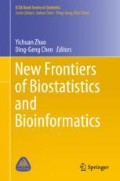Abstract
Advancements in science, technology, and medicine have contributed to the economic growth of the United States. However, this requires individuals to be trained for careers in biostatistics, bioinformatics and other areas of science, technology, engineering, and mathematics (STEM). Despite efforts to improve student recruitment and retention in STEM fields, the proportion of STEM graduates at the undergraduate level remains low in the United States, and is the lowest among underrepresented minorities. Several initiatives by the National Science Foundation (NSF), American Statistical Association (ASA), and academic organizations have invested in training individuals by developing programs to address issues that may be contributing to low recruitment and retention rates. Some factors may include lack of mentoring received from parents and teachers on STEM careers and less opportunities to explore STEM career options. In this study, a subsample of the High School Longitudinal Study (2009–2013) dataset (HSLS:09) is analyzed. Regression models were applied to evaluate mathematics achievement and student enrollment in STEM major/careers based on their individual participation in STEM activities and mentorship. Differences based on sex, race/ethnicity, and socioeconomic status (SES) were investigated. In summary, the aim of this work was to assess the significance of these stated factors in order to give insight into STEM education policy efforts. Our hope is that this work would shed light on the roles of mentors and student participation in STEM activities to motivate future programs aimed to recruit and retain STEM students.
Access this chapter
Tax calculation will be finalised at checkout
Purchases are for personal use only
References
Anderson, K. J., & Minke, K. M. (2007). Parent involvement in education: Toward an understanding of parents’ decision making. The Journal of Educational Research, 100(5), 311–323.
BenZvi, D., & Garfield, J. (2008). Introducing the emerging discipline of statistics education. School Science and Mathematics, 108(8), 355–361.
Chen, X. Stem Attrition: College Students’ Paths into and Out of STEM Fields. Statistical Analysis Report. NCES 2014-001. (2013). National Center for Education Statistics.
Griffin, K. A., Perez, D., Holmes, A. P., & Mayo, C. E. (2010). Investing in the future: The importance of faculty mentoring in the development of students of color in stem. New Directions for Institutional Research, 2010(148), 95–103.
Griffith, A. L. (2010). Persistence of women and minorities in stem field majors: Is it the school that matters? Economics of Education Review, 29(6), 911–922.
Harackiewicz, J. M., Rozek, C. S., Hulleman, C. S., & Hyde, J. S. (2012). Helping parents to motivate adolescents in mathematics and science: An experimental test of a utility-value intervention. Psychological Science, 23(8), 899–906.
Inter-university Consortium for Political and Social Research. (2016). High school longitudinal study, 2009–2013 [United States]. United States Department of Education. Institute of Education Sciences. National Center for Education Statistics.
Kader, G., & Perry, M. (2006). A framework for teaching statistics within the k-12 mathematics curriculum. In Proceedings of the Seventh International Conference on Teaching Statistics.
King, A. J., Fisher, A. M., Becich, M. J., & Boone, D. N. (2017). Computer science, biology and biomedical informatics academy: Outcomes from 5 years of immersing high-school students into informatics research. Journal of Pathology Informatics, 8, 2.
Musu-Gillette, L., Robinson, J., McFarland, J., KewalRamani, A., Zhang, A., & Wilkinson-Flicker, S. Status and Trends in the Education of Racial and Ethnic Groups 2016. NCES 2016-007. (2016). National Center for Education Statistics.
NSF. (2012a). Inclusion across the nation of communities of learners of underrepresented discoverers in engineering and science. https://www.nsf.gov/funding/pgm_summ.jsp?pims_id=505289
NSF. (2012b). Stem-c partnerships: Msp. https://nsf.gov/pubs/2012/nsf12518/nsf12518.htm?org=NSF
SAS Institute. (2015). Base sas 9.4 procedures guide.
Syed, M., Goza, B. K., Chemers, M. M., & Zurbriggen, E. L. (2012). Individual differences in preferences for matched-ethnic mentors among high-achieving ethnically diverse adolescents in stem. Child Development, 83(3), 896–910.
Acknowledgements
This research was in part funded by the National Heart, Lung, and Blood Institute (NHLBI) of the National Institutes of Health (NIH) under grant number T32HL072757.
Author information
Authors and Affiliations
Corresponding author
Editor information
Editors and Affiliations
Appendix
Appendix
Summary of observations used in this analysis are summarized in Table 13.10.
Rights and permissions
Copyright information
© 2018 Springer Nature Switzerland AG
About this chapter
Cite this chapter
Murillo, A.L., Tiwari, H.K., Affuso, O. (2018). Analysis of the High School Longitudinal Study to Evaluate Associations Among Mathematics Achievement, Mentorship and Student Participation in STEM Programs. In: Zhao, Y., Chen, DG. (eds) New Frontiers of Biostatistics and Bioinformatics. ICSA Book Series in Statistics. Springer, Cham. https://doi.org/10.1007/978-3-319-99389-8_13
Download citation
DOI: https://doi.org/10.1007/978-3-319-99389-8_13
Published:
Publisher Name: Springer, Cham
Print ISBN: 978-3-319-99388-1
Online ISBN: 978-3-319-99389-8
eBook Packages: Mathematics and StatisticsMathematics and Statistics (R0)

